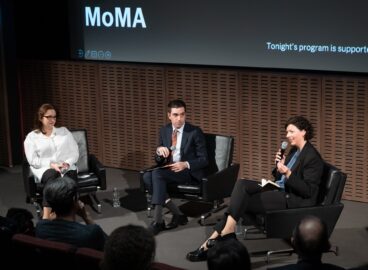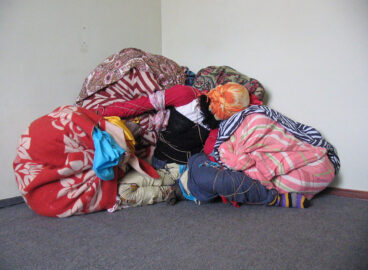The following excerpt is from Socialist Architecture: The Reappearing Act, published in Berlin by The Green Box in 2017. A collaboration between the architect Srdjan Jovanovic Weiss and the photographer Armin Linke—supported by the Graham Foundation—the book introduces the concept of an “architecture of Balkanization” and explores textually and visually what that might be in the landscape of the decentralized socialist society of Yugoslavia.
This excerpt is published on post on the occasion of the opening of Toward a Concrete Utopia: Architecture in Yugoslavia, 1948-1980, on view at The Museum of Modern Art July 15, 2018–January 13, 2019.
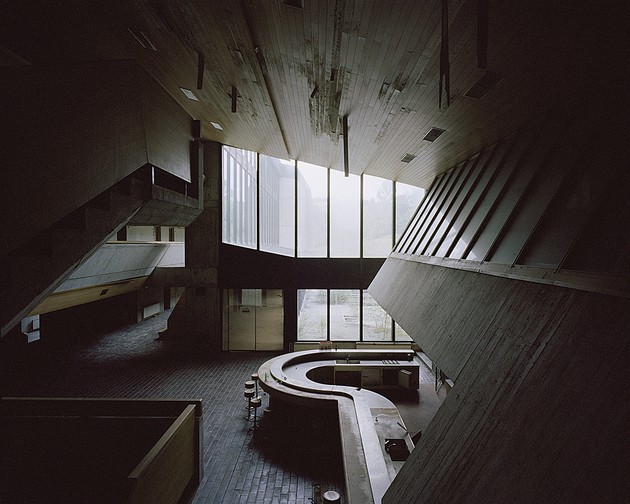
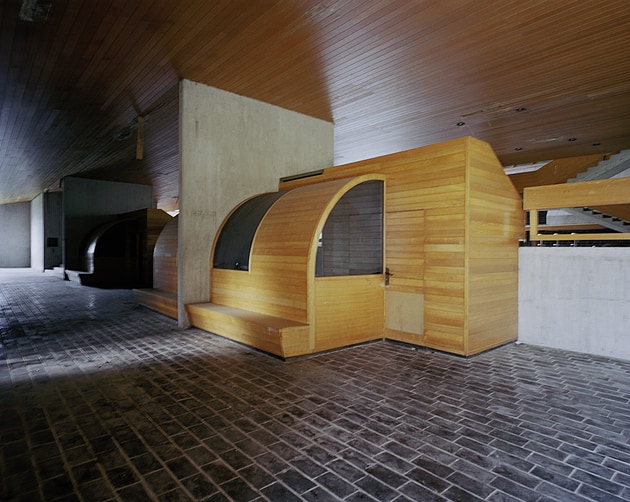
“…decentralized planning is the extremely significant factor in the economic efficiency of planning particularly in a self-managed and democratic planning system. Without a certain degree of decentralization, the planning system would become the tool in the hands of the state.”
-Edvard Kardelj1Edvard Kardelj, The System of Planning in a Society of Self-management: Brioni Discussions (Belgrade: Socialist Thought and Practice, 1976), 12. Note: Kardelj was the chief ideologue of socialist Yugoslavia.
This book presents experiences of exploring decentralized socialist architecture across Yugoslavia between 2006 and 2011. Like on a safari, Armin Linke and I found these sites appearing as spatial creatures that we believe were not in the intended official view. At times we played ball in empty halls spontaneously with curious kids who were around. At times we had to ward off angry people (and stray dogs and birds) who saw us gathering documentation. Yet, we were in a position to immerse into the success of the architecture of socialist cause. These places that had been made in the name of global inclusion of Yugoslavia’s soft socialism, today perform the reappearing act of their own success and spatial magic. These locations are now emptied of the ideology that made them. On the other hand, they are full of a new kind of life, and today this significance is more open-ended than ever intended.
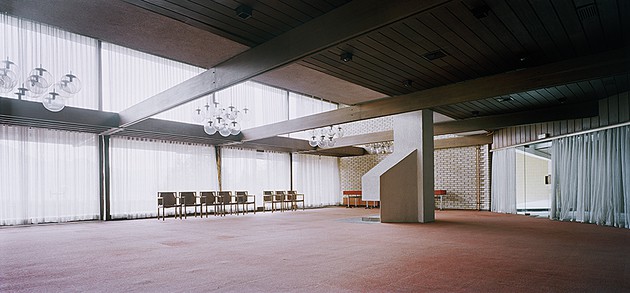
The Socialist Federation of the Republic of Yugoslavia vanished during the early 1990s. It was Balkanized into a number of emerging democracies and former socialist states. Each of these former Yugoslav states inherited monuments, buildings, landscapes, and infrastructures, which were constructed specifically for Yugoslav soft socialist postures and representations. After Yugoslavia vanished, most of the inherited institutional architecture was left vacant and in a state of limbo between repurpose and reuse, or continuing as modern archaeological ruins. The Reappearing Act book interprets the quandary facing a few emerging democracies today: Croatia, Macedonia, Montenegro and Serbia, that came out of Yugoslavia among other new states. The effects of the lack of a decisive outcome for their abandoned socialist architecture creates the spatial experience and the fate of historical Yugoslav architecture—as a form of success.
Like a magic trick, the vanishing act constitutes the re-appearance of things that have been lost from other forms and other mediums. For traditional architecture, which is materially and spatially bound to its own body, organization and loci, vanishing appears as a particular and destructive process of removal and dismantling. However, for architecture tailored to socialism, the disappearance of the very ideology that constructed it can put into question the traditional relation between body, form, and social and political intentions in architecture. Instead of claiming that the vanishing of an idea causes the non-negotiable material appearance of the neglect of the past, what could be proposed is that the vanishing act of socialism leaves this ideology in the past as such. Thus the vanishing act pushes the remaining socialist architecture towards the future. What has vanished always reappears in unexpected forms that surprise us.
In the time of transition after socialism the archaeology of architecture from socialist Yugoslavia got differentiated in terms of public memory. The Vanishing Actshows that the memorials of the former socialist regime in Yugoslavia are mostly located in the countryside in between these new capitals. The countryside that these memorials occupy are in a liminal space in between seats of political power. We have also demonstrated a connection between the materialization ofBalkanization to the concept of timeliness coming from the discourse on theimaginary by Maria Todorova. This was done in an attempt to ground the idea of the imaginary and its subsequent discourse of the metaphorical Balkanization into a material terrain where we trace a concept we have termed the architecture of Balkanization. By traversing eight contemporary capital cities of former Yugoslavia we see how Todorova’s concept of timeliness operates across multiple and overlapping territories with various stages of the architecture of Balkanizationoccurring simultaneously. From its rendition as autonomous zones in Ljubljana, via self-regulated urbanism in Serbia and Macedonia, climatic architecture in Tirana to an anti-climax in Sarajevo, each producing a specific, distinct type of spatial practice, on the architecture of Balkanization.
The traditional perception of socialism as a unified, centralized political system can be misleading in observing socialist Yugoslavia as a uniform territory. The prior political arrangement of the territory, unified in socialist-extrovert Yugoslavia and socialist-introvert Albania, held looser control over the uniform expression in architecture. Furthermore, we may be misled too easily if we accept that the fall of Yugoslavia was a severing of socialist uniformity from democratic pluralism. The thesis in this book is that due to the particularly softer version of socialism in the former Yugoslavia under Josip Broz Tito, the uniformity of representation in architecture did not actually exist, nor was it imposed as a political program. Yugoslavia’s political mechanism did go to great lengths to maintain the particularity of its constitutional parts. In order do so, the politics of engaging spatial practices were designed on a rotational basis between Yugoslav republics and Autonomous Provinces. Thus, the fall of Yugoslavia did not break the continuity of the ethnic-state particularity of spatial practices. Instead, theBalkanization of Yugoslavia in-situ enabled into multiple new countries and capital cities added a higher degree of national particularity. The national particularities were superimposed over Yugoslavia’s internal distinctions in the period of late socialism. This work explores a series of memorials, monuments, and political institutions such as the museums or homes of the revolution as they are today— mostly empty. The reason for looking at this architecture is not to comment on their state of being defunct, but to examine the plurality of architectural approaches to memory and representation of socialism, and juxtapose the diversity of these approaches to that of the unregulated construction in the emerging democracies.
The recent geopolitical change in favor of nationalism is practiced in the distinction of emerging capital cities coming out of Yugoslavia and its own self-Balkanizationprocess. In the past there was one capital city of Yugoslavia: Belgrade, and now there are six more: Ljubljana, Podgorica, Prishtina, Sarajevo, Skopje and Zagreb (in the alphabetical order). This makes Balkanization a successful producer of capital cities, at the rate of 700% increase of capital-ness. The Vanishing Act, like in the magician Houdini’s performance is not about disappearance, but about re- appearance in unexpected ways.
Once it vanished, Yugoslav socialism left scores of architecture seemingly behind.That architecture, tailored to the particular characteristics of Yugoslav socialism, is now mostly abandoned and in disrepair, but more public than they ever intended to be. The best examples of this destiny are the two institution buildings left alone in the birthplace of Josip Broz Tito in his place of birth in Kumrovec, Croatia: TheFormer Yugoslav Memorial Home and the Political School. Both built as part of a socialist political resort in the years between 1974 and 1981, the structures stand open, neglected, and for sale. They were built as part of the state-wide initiative to find a suitable location for the education of aspiring politicians in the former Yugoslavia. The 1970s and 1980s were crisis years in Yugoslav socialism. The economy was in decline, Tito was approaching old age. Latent nationalist forces, which Tito had kept at a distance, were regrouping. Yet the commissions for the politically motivated architecture went forward. The Yugoslav Memorial Home was built in 1974, the Political School in 1981. The site is surrounded by the varied topography where Josip Broz Tito was born and where he spent the early part of his life.
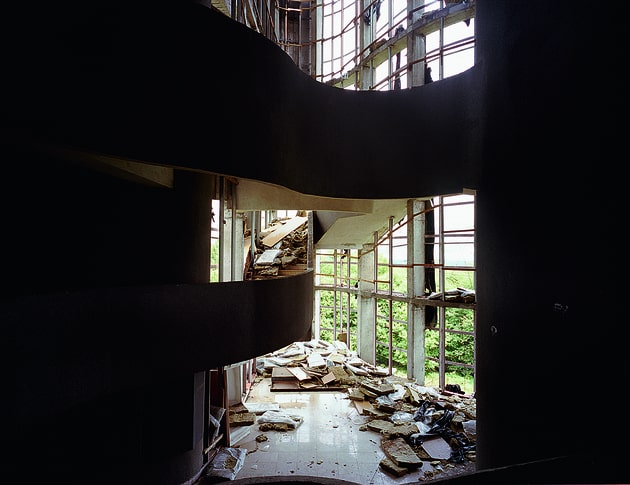
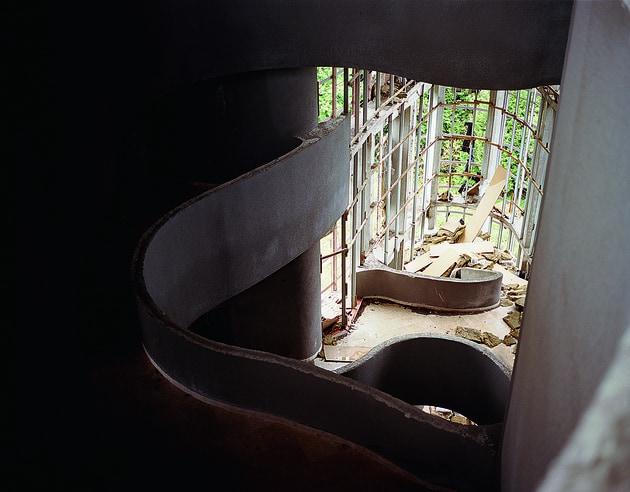
Petrova Gora
Petrova Gora in Croatia is one of many languishing memorials from the socialist era of the former Yugoslavia. Conceived in 1981 by Vojin Bakić, a Croatian sculptor who won many state-funded commissions, working with the architect BranislavŠerbetić, the project was designed as a 12-story-tall social center, set on the site of a partisan field hospital used during World War II. Finally completed in 1989 as a monument to Yugoslavia’s resistance fighters, the memorial was used as intended for only a brief period before the eruption of the Balkan crisis. The wars that ensued scattered refugees around the region, practically erasing the political cause this structure was meant to embody.
Today, Petrova Gora stands unused and empty, but open, thanks to the neglect passively offered by Croatia’s democratic government. Anyone can come here, enter the site, walk inside the monument, and wander upward through twelve interconnected levels all the way to the roof. In fact, the near-by residents have already appropriated the material surface of the memorial by pealing off its titanium panels and taking them away.
The feeling of melancholy inspired by Petrova Gora is overwhelming, but it is irresistible to call it beautiful. Furthermore, an astonishing aspect of this monument is that its interior is the size of a small Guggenheim museum, positioned on a dramatic hilltop site. It is also significant that the building is the work of an abstract artist, and that the site’s architect played only a minor role.
Contemporary artists have discovered this inhabitable monument and are embracing Petrova Gora in their work. Take the video produced by David Maljković, which portrays the structure far in the future as a neglected fiction. Other projects and expeditions to the site have produced similar imagery, evoking “nostalgia for the future.”
All of these projects raise awareness about this exceptional work, and about the exceptionality of Yugoslav socialism when compared to the idolatry of the Soviet Bloc. However, these artists’ projects fail to ignite strategic thinking and analysis, especially within the context of contemporary practice, about ideologies deploying art in place of design. Moreover, little if no work has been done to relate this monument to the American influence upon Yugoslav cultural policies during the Cold War, making Yugoslavia an ally to the West and offsetting the Soviet East. American abstract art, conceptual art, and corporate architecture all play provocative roles in this history. While some artists exhaust the repertoire of visual interventions, the time is ripe for architects to step in.
Yet time is also limited for further action. Visitors to Petrova Gora have already spotted men with geodesic equipment measuring the site of the memorial and the monument itself. This may mean that we are already late on the scene, and that there is perhaps little time to think of a strategy to put this monument back in the future, either for an authentic use (which few would fund without a neoliberal zeal for profit returns), or preserved as a beautiful ruin.
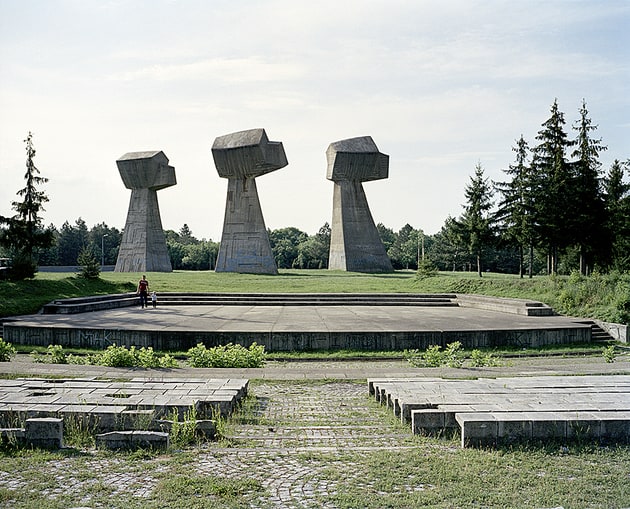
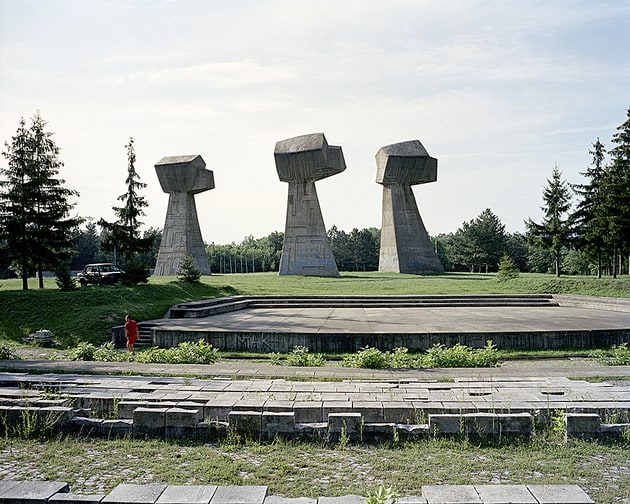
Bubanj Memorial Park
Since the end of socialism, Bubanj Memorial Park emerged in public view as a place to by-pass the ideology simply by using it as a park. An immense and generous territory, it became frequented by everyday visitors, young families and their children. The very large scale of the memorial park has proven to be too big of a territory to be converted into anything else. Its size works in favor of its preservation. At the same time, Serbian and local government finds itself preoccupied with the repair of damage caused by Milošević-era economic policies which allowed criminals to become a dominant market sector. As a result of attention and energy spent elsewhere, Bubanj Memorial Park lives in a state of neglect. In fact, it is the state of neglect that keeps the memorial park open to all. The vanishing of socialism reappears in the common and spontaneous non- ideological use of the open space by the country’s citizens.
Today the Bubanj Memorial Park is a favorite family field-trip destination for Nišresidents, especially on May 1st, International Day of Labour. The vastness of the memorial park territory preserves this land from being commercially exploited. Speculatively, the size of the park de-sacralizes the nostalgic memory of socialism of its ritualistic, almost sacral ideological elements. Said differently, the process of stripping away the spiritual aspects from this socialist memorial happens through a voluntary and civil profanation of use. Yet at the same time, the ongoing de- sacralization of the memorial is not showing through as the de-socialization of the park. The territory turns from memorial to recreational, where paths walked and crossed are different from the ones intended. During the killing fields between 1942-44, walking patterns were controlled in yet not fully known patterns by the German perpetrators, executioners and gravediggers for mass burial. During the period between the end of World War II and 1963, a burial pyramid was erected to commemorate the dead. Very little is known about the walking patterns of commemoration. After 1963, new walking patterns occupied the park with a larger and more sequenced territory of the memorial where bus tours would pour in pupils from all over Yugoslavia to “experience” a didactic walking pattern and culminate in the open air auditorium with the three fists of resistance as the back-drop. Today, walking patterns are non-prescribed and open for civilian use without the need to follow any didactic sequence. Thus the profanation of this partisan memorial park is not only a form of de-sacralization of a land containing thousands of buried bodies in mass graves, it is a form a self-organized transfusion of the territory of the memorial into a place that is a necessity for everyday and timely needs.
The timeliness as an aspect of Balkanization was clearly addressed in Kardelj’s rotational key for architectural and urban commissions. We can extract a theory that Todorova’s timeliness of centrifugal Balkanization meets Kardelj’s strategic attempt in the rotational timing of commissions. He was hoping for the centripetaleffect to meet the centrifugal architecture of Balkanization. Memorial parks likeBubanj—built in Serbia by a Croatian artist—are architectural places that were meant as a block between the forces of Balkanization and suggest the possibility of a lasting balance. We have seen how the Memorial Home in Kolašin survived the vanishing act of socialism simply because the memorial is inhabited not only by memory, but by the everyday needs for an administration. In the parks like Bubanj, this program, other than memorialization, is secured by their use as a place of everyday recreation.
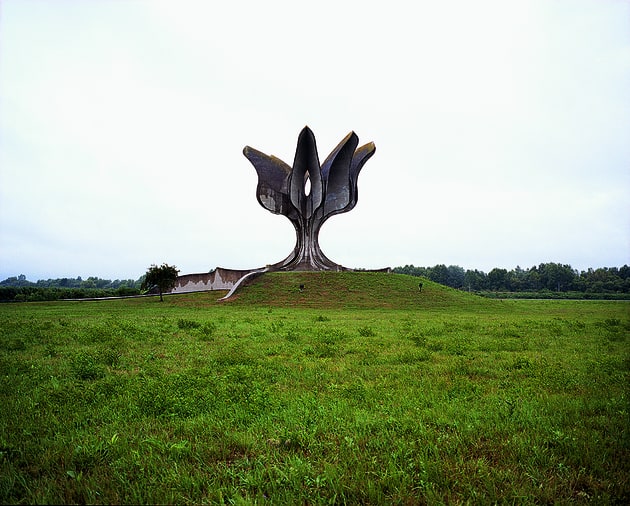
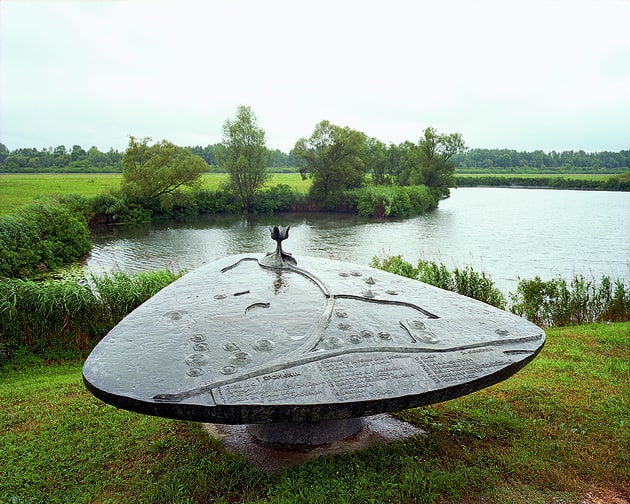
Jasenovac Memorial
The Yugoslav rotational key also allowed Belgrade architects access to major commissions for memorials to partisan victory and losses in World War II in other republics, such as Croatia, and Bosnia and Herzegovina. Architect Bogdan Bogdanović, to whom an entire separate study should be devoted, was both a privileged communist in political power structures and a dissident in his practice. World War II and the communist victory over fascism cemented distinct ethnic fragments into a singular, Yugoslav memory of resistance. As Lidija Merenik, critic and contemporary art historian from Belgrade, wrote, socialist “Yugoslavia early got rid of socialist realism as the official art” leaving abstraction to reign over figuration. The Yugoslav socialist use of abstraction in art and architecture was there to act as force against the Balkanization of the country into ethnic parts. This approach to solidifying memory in abstraction remained in vogue long after World War II. Yet, as Merenik remarks, both social realism and figuration have been “hidden below a carpet” and left unattended, until it made a gradual and the explosive comeback during late socialism, violent crisis and its aftermath.2Lidija Merenik, “The Yugoslav Experience, Or What Happened To Socialist Realism,” Moscow Art Magazine 28 (1998). Bogdanović was a rare architect and artist who dared to use figurative (masterfully abstracted) motif in his architectural work for the partisan memorials. His largest and most prominent work expands the idea of partisan or ethnic victims to the memory of the holocaust. This work is Bogdanović’s design of the former concentration camp Jasenovac in eastern Croatia, then reworked into a large memorial park. The Jasenovac Memorial Park thus consists of an expansive landscape design of the grounds of the concentration camp and a monument in the form of an abstracted flower. The actual locations of the mass graves were marked by round land formations made of soft reams and earthen craters. The heart of the memorialization lies in the architectural sculpture, The Flower, which also houses a memorial center. The Flower was completed in 1968 as a large- scale, symbolic commemoration of the victims of the crime in Jasenovac. It also invited discussion of the politics of social symbolism and inspired the search for icons other than abstraction. Tito was reported to have attacked abstract art as a “dark wave” in film.3Ibid. Indeed, Bogdan Bogdanović was a known dissident. However, under soft socialism, authorities who preferred figuration nevertheless sponsored abstraction and Bogdanović used this key moment to unmask hidden socialistdesire for classical architecture and figurative art. This desire, already implemented by Stalin as the Soviet neo-classical architecture, before socialist Yugoslavia existed, was largely a taboo in Tito’s postwar Yugoslavia. Thus the concepts embedded in The Flower seem to run on two distinct levels: one towards improving on abstraction as a form of social amalgamation and the other one to unmask the Yugoslav socialist policy that saw non-communist symbolism as taboo. The material metaphor in the architecture and the engineering of The Flower in concrete prevailed.4This is not the only example where a communist architect, usually dealing with architectural or abstract geometries proposed literal, figurative and non-abstract monuments for leftist systems. From Le Corbusier’s hand in Chandigarh to Oscar Niemeyer’s monuments in Brasília.
The vanishing act of socialism in 1980s and 1990s left the Jasenovac Memorialabandoned and unmaintained. In 2009, The Flower was partly repaired and re- inagurated, not as a memorial to the Jewish holocaust, but to all “victims in the anti-fascist struggle”. The question is: Is The Flower a materialized idea of socialist architecture, or mere architecture from socialism? The vanishing idea of socialism will move us closer to Kardelj’s strategic and Todorova’s analytic relationship to thecentripetal and the centrifugal forces of Balkanization, balanced within the dissidence of Bogdanović’s architectural and sculptural spatial practice. Here we need to remark that ideological architecture has been debated in the case of neo- classical architecture in both nationalist and socialist systems in history such as Hitler’s or Stalin’s. It is generally accepted that through the release of Albert Speer, architect for the Third Reich, there is no National Socialist architecture, only architecture in the National Socialist period. On the other hand, the case of architecture in the Soviet Union is presented in the thesis by Alexei Tarkhanov and Sergei Kavtaradze as Stalinist architecture and as the materialized idea of socialist architecture.5See: Alexei Tarkhanov, and Sergei Kavtaradze, Stalinist Architecture (London: Laurence King, 1992). Thus, in order to be critical for the discourse of the architecture of Balkanization, socialist architecture alone is investigated as an idea of socialist architecture solidified in architectural or landscape material.6Mate Piškor/Epeha, “Predsjednik Mesić U Jasenovcu: U Hrvatskoj i Europi Nema Mjesta Za Ljude Koji Veličaju Fašizam,” Slobodna Dalmacija, published April 26, 2009, web. August 9, 2012, accessed August 9, 2012, http://www.slobodnadalmacija.hr/Hrvatska/tabid/66/articleType/ArticleView/articleId/52010/Default.aspx The question remains: does the vanishing idea of socialist architecture leave us with socialist architecturealone?
- 1Edvard Kardelj, The System of Planning in a Society of Self-management: Brioni Discussions (Belgrade: Socialist Thought and Practice, 1976), 12. Note: Kardelj was the chief ideologue of socialist Yugoslavia.
- 2Lidija Merenik, “The Yugoslav Experience, Or What Happened To Socialist Realism,” Moscow Art Magazine 28 (1998).
- 3Ibid.
- 4This is not the only example where a communist architect, usually dealing with architectural or abstract geometries proposed literal, figurative and non-abstract monuments for leftist systems. From Le Corbusier’s hand in Chandigarh to Oscar Niemeyer’s monuments in Brasília.
- 5See: Alexei Tarkhanov, and Sergei Kavtaradze, Stalinist Architecture (London: Laurence King, 1992).
- 6Mate Piškor/Epeha, “Predsjednik Mesić U Jasenovcu: U Hrvatskoj i Europi Nema Mjesta Za Ljude Koji Veličaju Fašizam,” Slobodna Dalmacija, published April 26, 2009, web. August 9, 2012, accessed August 9, 2012, http://www.slobodnadalmacija.hr/Hrvatska/tabid/66/articleType/ArticleView/articleId/52010/Default.aspx
